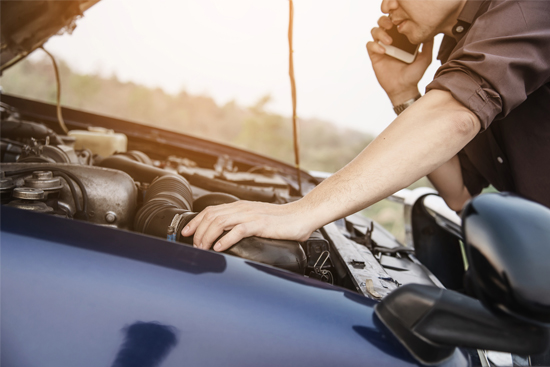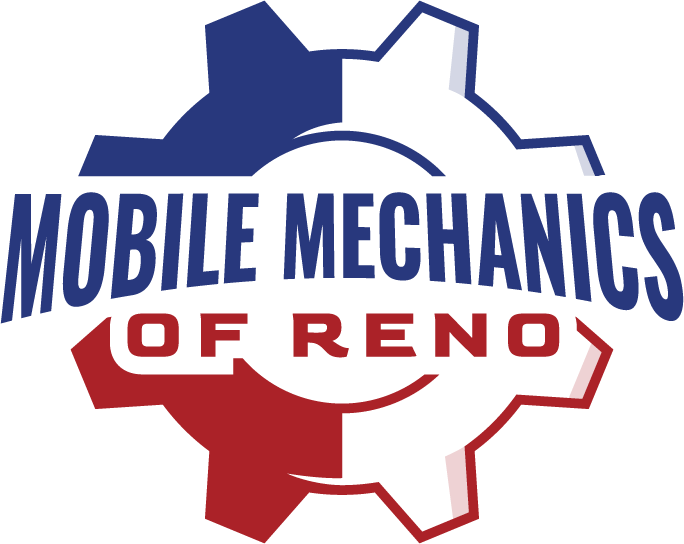Car Fails To Start
The battery powers the starter, which is a small motor. It starts the engine in your vehicle. A starter relay transmits power between the battery and the starter motor. A direct current starter motor and a solenoid switch make up the system. The motor starts the engine by turning the car’s crankshaft, while the solenoid switch activates the starter’s drive gear and closes the motor’s electrical contacts.
These parts don’t normally malfunction entirely unless they’ve been subjected to excessive wear and tear or have been neglected. When your car won’t start, the problem may be with the battery, alternator, or starter. It is really hard to tell where the problem is coming from. At Mobile Mechanic Reno, we offer local car repair services wherever you are.

So how would you know where the issue is? A good place to start is with the battery. A battery can last between three and five years in most cases. If the battery isn’t fully charged, the starter will not function. The common indicators of battery failure are listed below:
- Grinding or whining noises upon starting the vehicle
- Lights don’t turn on
- Engine fails to ignite
- Smoke
- The starter motor stays on even after releasing the key
- The warning light turns on
Given the instances above, the battery would almost certainly need to be replaced. You may do it yourself, but it’s best to hire a skilled local mechanic to do it for you. If your battery isn’t the issue, then they can inspect and find out where the problem is coming from.
When the engine is turned on, it is in charge of charging the batteries. It also serves as a source of energy for the electrical system. It usually lasts between eight and twelve years. It won’t charge the battery properly if it continues to malfunction. When the alternator fails, you will notice the following:
Lights are dim; even the dashboard isn’t as bright as it normally is
- The warning light is on
- Burning smell
- Grinding noise
- Engine dies even after jump starting
Your on-site technician will make a conclusive alternator diagnosis. Check the starter if the trouble isn’t with the battery or alternator. When you turn the key or press the start button, this part is in charge of starting the engine. You’re not going anywhere if it’s not running.
Keep an eye out for the following signs:
- The dashboard will light up, but the car will not start.
- The engine will not start even after the jump start.
- Clicking noise when you turn the key.
If you can’t make your vehicle start, only a skilled mechanic will. Don’t hesitate to ask for professional help. Recommendations from your trusted local mechanic can help you find out if your car parts need repair or replacement.
The Battery Is Not Charging
It’s all too easy to believe that it’s always the battery’s fault if the car doesn’t start. You get the jumper cables out, jumpstart the engine, and you’re good to go. It could work in some cases, but not all of the time.
Here’s a short rundown on some of the most frequent causes of a discharged battery:
- You’ve forgotten to switch off the lamps or some other accessory that uses battery power even though your automobile isn’t running.
- The battery does not get recharged when you drive the vehicle, indicating a mechanical charging problem.
- The battery has an electrical drain, which may be triggered by a poor alternator.
- The battery is worn out and has to be replaced.
Here’s how you can check why your battery won’t charge:
- Activate the headlights. It may simply be a wiring issue if the brightness is fine. It could be the battery if they don’t turn on or aren’t as bright.
- Check the voltage with a voltmeter.
- Calculate how long the battery has been installed in your vehicle.
- Check for corrosion or other flaws with the alternator and its cables.
When it comes to driving your vehicle, the charging mechanism is crucial. You can’t just guess what the problem is. Make an appointment with your auto repair mechanic in Reno, NV.
Lights Don't Function
When driving at night or in the dark, you depend on your car’s lights. When your lights go out, you won’t be able to see the driveway, and other drivers won’t be able to see you either. Furthermore, if you are spotted driving with faulty lights, you can be sanctioned by authorities. It’s best to contact your mobile mechanic if you see or encounter either of the following issues:
- Check for any broken fuse or wire.
- Test the dimmer button if the headlights aren’t working properly. It should be easy to take out and fix or replace.
- A defective ignition key is one possibility. The ignition switch will only provide electricity to electrical components and cannot start the engine.
It is usually impossible to patch a circuit breaker that has been broken. Since circuit breakers are distributed across the lighting system, you must determine which ones need to be replaced.
Car Horn Doesn't Work
One of the oldest safety features of a vehicle is the horn. It alerts other drivers to an incoming car and serves as a warning signal. It can cause potential risk for you and other drivers if the horn isn’t working. It is still illegal to drive without a functioning car horn.
Here are a few possible explanations why the car horn isn’t running:
- The horn is powered by electricity. You will need to repair the fuse is broken.
- In the fuse box, look for the horn relay. If the fuse isn’t the issue, the relay might be. It’s also easy to replace if necessary.
- Check for dirt on the wire connectors. Sometimes, a good cleaning can do the trick.
- Horns get wet and muddy easily because they are located so close to the front of the engine, and the connections will rust.
- Perhaps the horn itself is defective. Try attaching the horn to a jumper wire directly, but proceed with caution. If the horn is still running, it can be very noisy.
It may be a problem with the airbags or a faulty horn turn. Both are found on the steering wheel and can be checked by a skilled auto mechanic.
Windshield Washers Are Not Functioning
To clear debris from your windshield, the washer pump in your car sprays washer fluid from the tank by hoses and onto your windshield. When you turn on the washer, it doesn’t always work. Here are a few alternative explanations.
- The tank or reservoir is fully drained. If this is the case, just add fluid to the tank. Be sure there are no puddles on the ground or you could leak.
- Rubber hoses connect the reservoir to the wiper, and they can snap, crack, or leak. Examine, then fix or replace as needed.
- The washer fluid may be dirty. Washer fluid comes in a variety of colors, but most of them are clear. Dirt can be present if the liquid is cloudy.
- Your washer can even stop working due to a blown fuse. The fuse must be replaced if this is the case.
If both the fluid and the fuse are working well, the issue could be with the pump. This could be a bit more difficult to verify and diagnose. It’s best to get a competent technician to look it over.
Faulty Windshield Wipers
You usually don’t think much about your car’s windshield wipers until the weather is terrible and you need them. Windshield wipers are often overlooked, but plays an important role There are a few possibilities for why the wiper isn’t working:
- The state of the wiper blades affects how well they function. If the blades are torn, they won’t be able to easily clear dirt or moisture.
- A brush can be used to clean heavy or damp snow from the wipers. If you’re dealing with a lot of snow, it’s a smart idea to invest in winter wiper blades.
- The wiper motor is an electric device that can wear out over time. The wipers would not work if the engine is damaged.
- The wiper motor’s fuse will also burn out if it is overloaded.
- The pivot nuts connecting the wiper arms to the wiper transmission may be loose. When this occurs, one wiper will shift but the other does not.
If you have any of these problems, and if you’re not sure what’s wrong with your wipers, it’s better to consult your local mechanic.
Power Mirrors Not Working
To see what’s in front of you, you’ll need eyes. When driving, the best way to look to the side and behind you is to make sure the mirrors are correctly positioned. Accidents can also occur while driving without a mirror. It’s easy to fix a cracked mirror. What about the use of power mirrors? There are a few problems with power mirrors that you should be aware of.
- The power mirror uses a collection of buttons, a plastic mirror glass holder, and a small motor to switch to the correct setting. Your mirror would not shift correctly if this break.
- .The mirror switch needs replacement.
- It’s possible that the power mirror control within your car has dirt behind the button or that the switch itself is faulty.
- Ice can also prohibit your mirrors from moving during harsh, and frozen climates.
- It’s also possible that the wires connecting the window switch to the window motor are broken.
Windows are necessary to drive well and safely. If you’re experiencing some of the problems mentioned above, calling the nearest local mechanic right away is the best move.
The Ignition Switch Has Failed
If your car won’t start or starts but turns off right away, there might have a problem with the ignition switch. As the ignition switch is being used often, it’s normal that it deteriorates over time.
Remember that a car that does not run will not get you anywhere. It’s safer to get your car tested by a local mechanic or your mobile repair service as soon as possible if you notice any of the issues such as:
- The ignition switch that failed to operate could be because of a corroded electrical circuit.
- If the key won’t turn, double-check that you’re using the correct one. Be sure the ignition lock isn’t turned on. If the key always won’t spin, something may be blocking it from correctly aligning with the keyhole.
- Control to the ignition and fuel systems could be turned off if the ignition switch fails when the engine is running, causing the vehicle to stall.
- A flashing dashboard may also indicate an issue.
When the starter motor doesn’t make any sound, it may be an indication of an ignition failure.
Sensor-Related Issues
Sensors provide information to the Powertrain Control Module (PCM), which allows the PCM to make important control decisions. The PCM can not make the appropriate control decisions if the input data is incorrect. Incorrect data can lead to issues with pollution, efficiency, and other issues.
Here are some sensor issues to look out for:
- Many drivers are perplexed by the Check Engine Light because it does not indicate the nature of the issue.
- Overheating can cause damage to coolant sensors.
- Airflow and engine load are estimated using throttle position sensors. As the mileage on these sensors increases, they can depreciate.
- Contaminants in the exhaust can cause oxygen sensor failures.
- The PCM gets details about how much load is on the engine from manifold absolute pressure (MAP) sensors. Hesitation, fuel mixing, and spark timing issues can all be caused by MAP issues.
- The airflow into the engine is measured by the Mass Air Flow (MAF) sensor. This data is essential for controlling the fuel mixture.
- The relative speeds of the key input and output shafts are monitored by speed sensors. Problems with the sensor may be caused by a wiring issue or a sensor loss caused by iron particles stuck to the tip.
- Changes in air temperature are monitored using inlet air temperature (IAT) sensors. Increases in pollution, fuel intake, and other problems may be caused by a sensor that isn’t working properly.
- Tire pressure monitor systems (TPMS) are used to keep track of tire pressure to ensure that it stays within recommended limits. Any sealer materials allow these sensors to malfunction.
- Changes in air temperature are monitored using inlet air temperature (IAT) sensors. Increases in pollution, fuel intake, and other problems may be caused by a sensor that isn’t working properly.
- Tire pressure monitor systems (TPMS) are used to keep track of tire pressure to ensure that it stays within recommended limits. Any sealer materials allow these sensors to malfunction.

